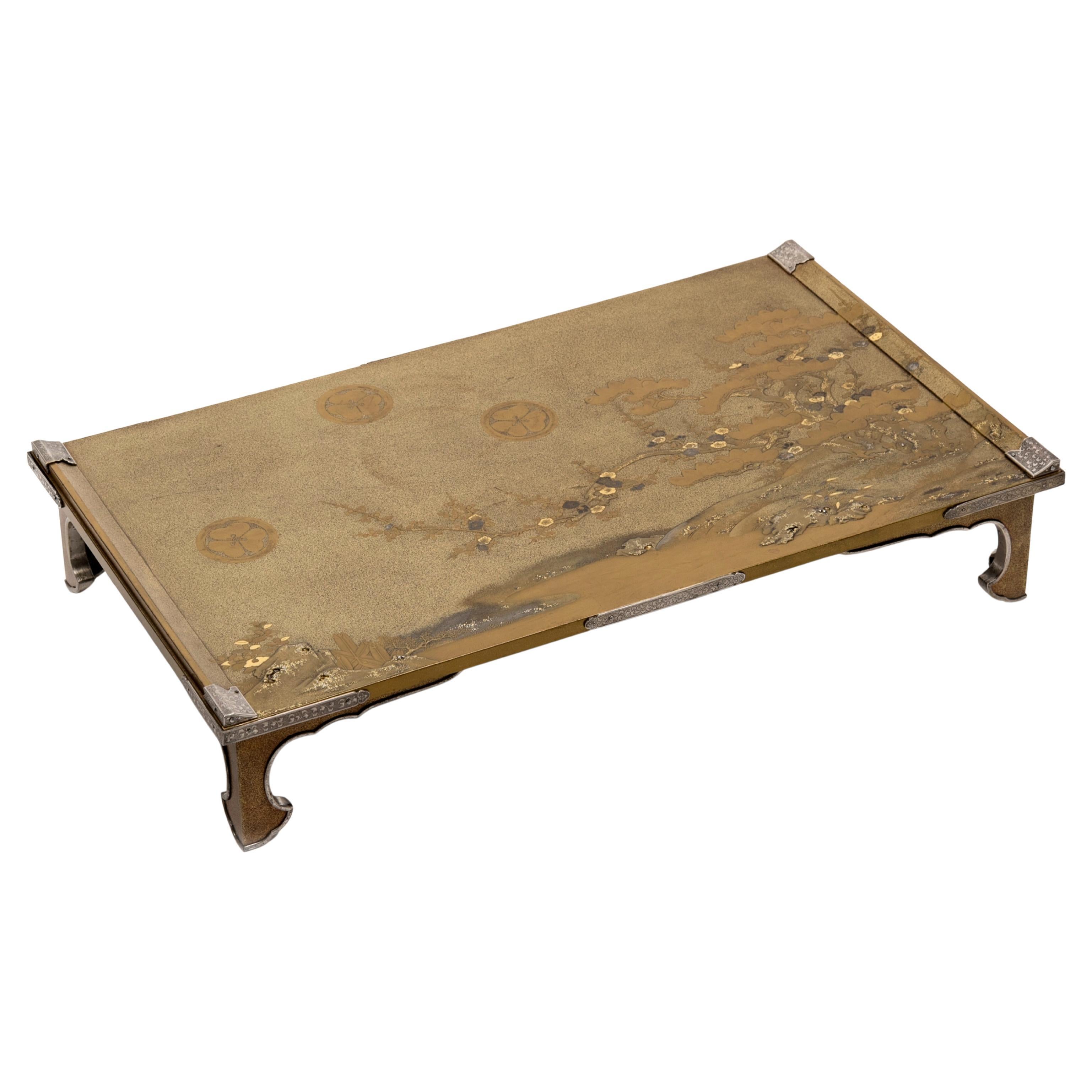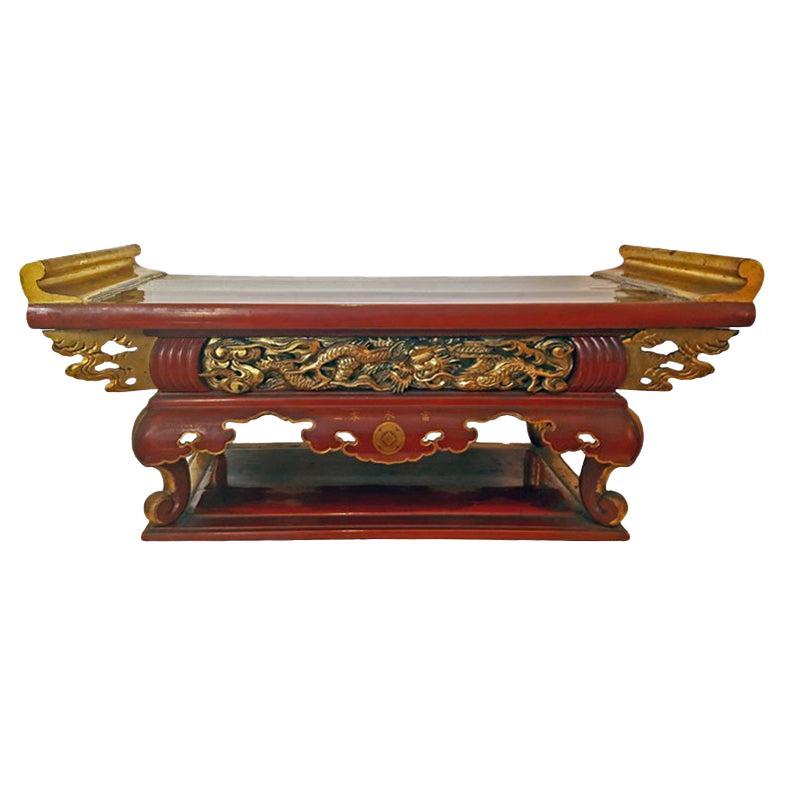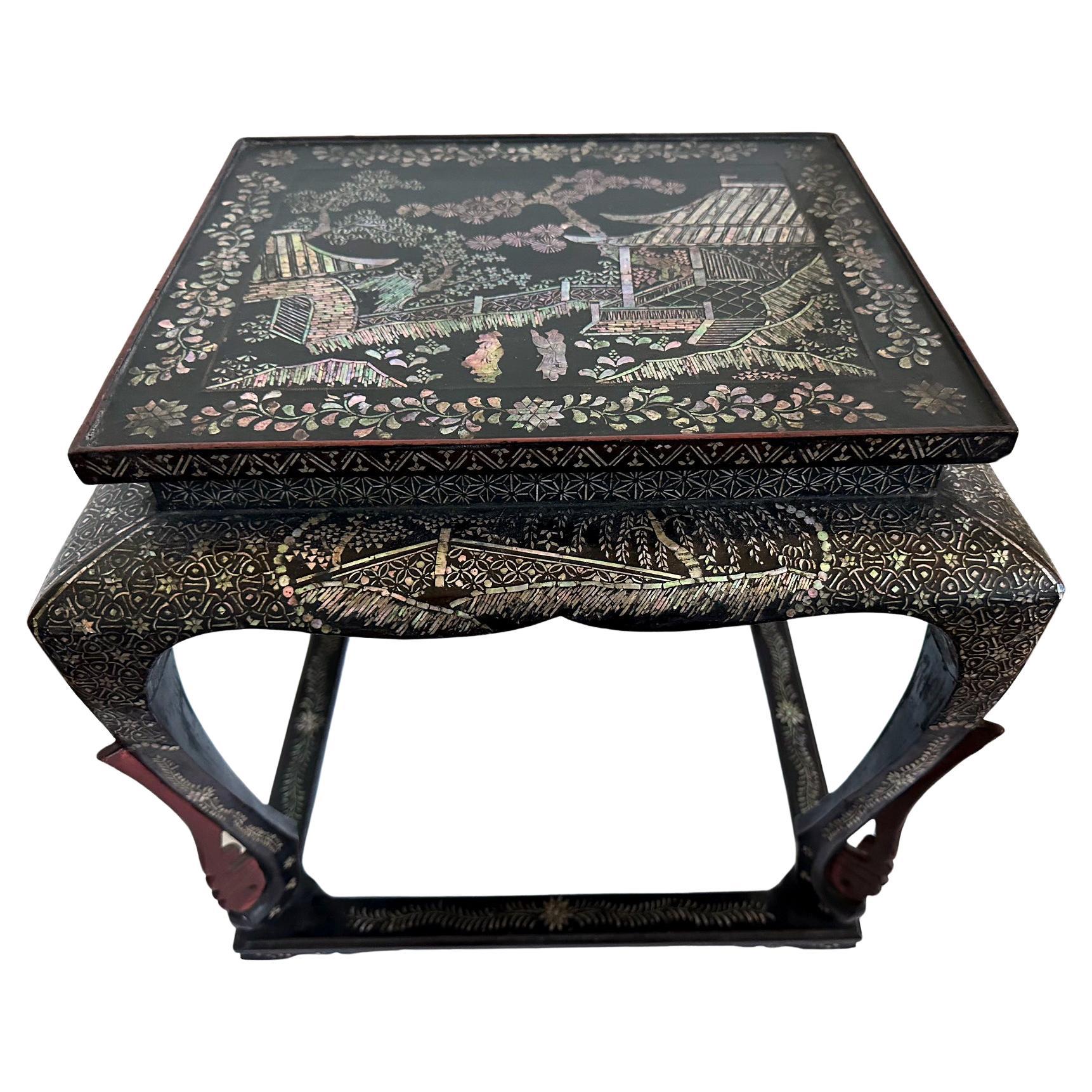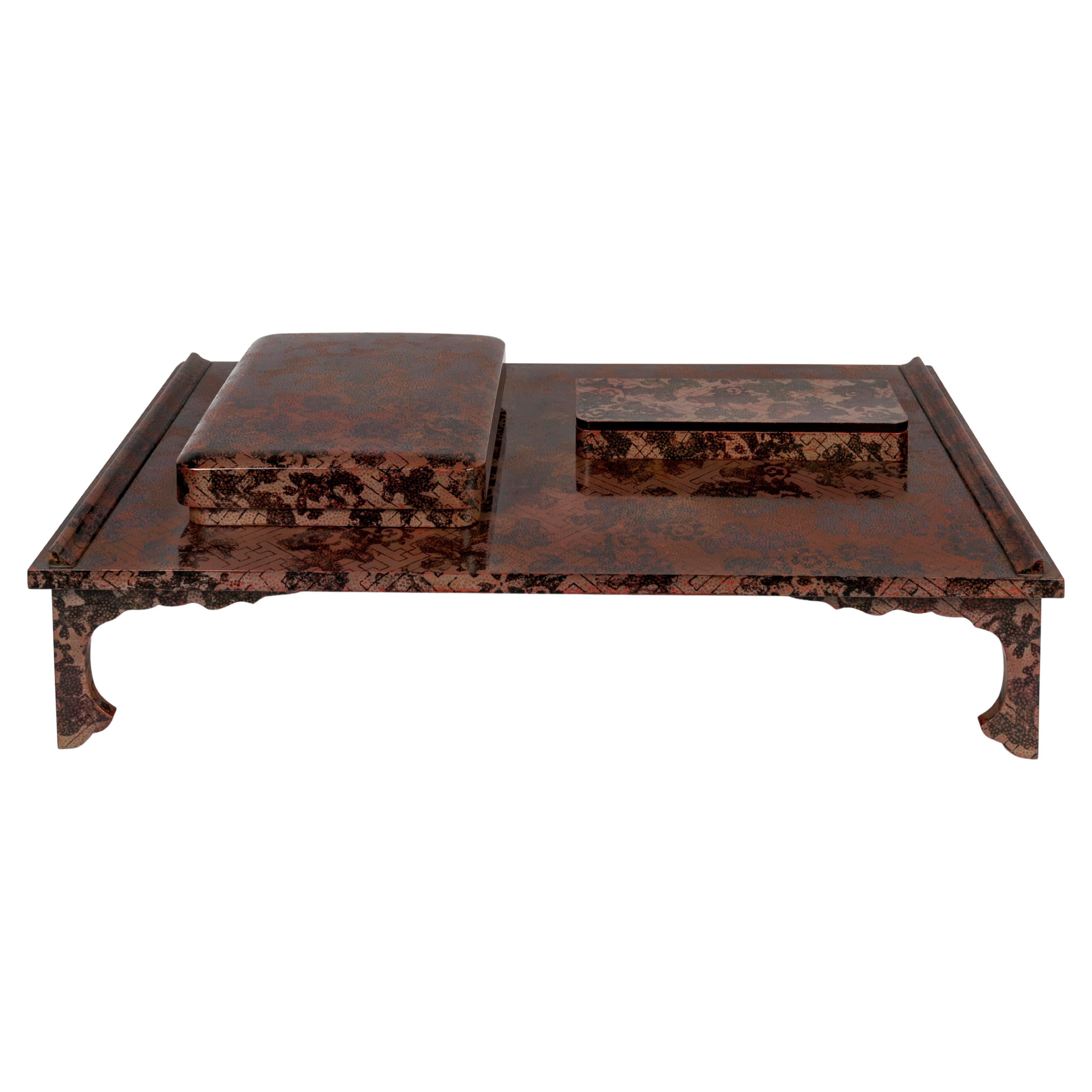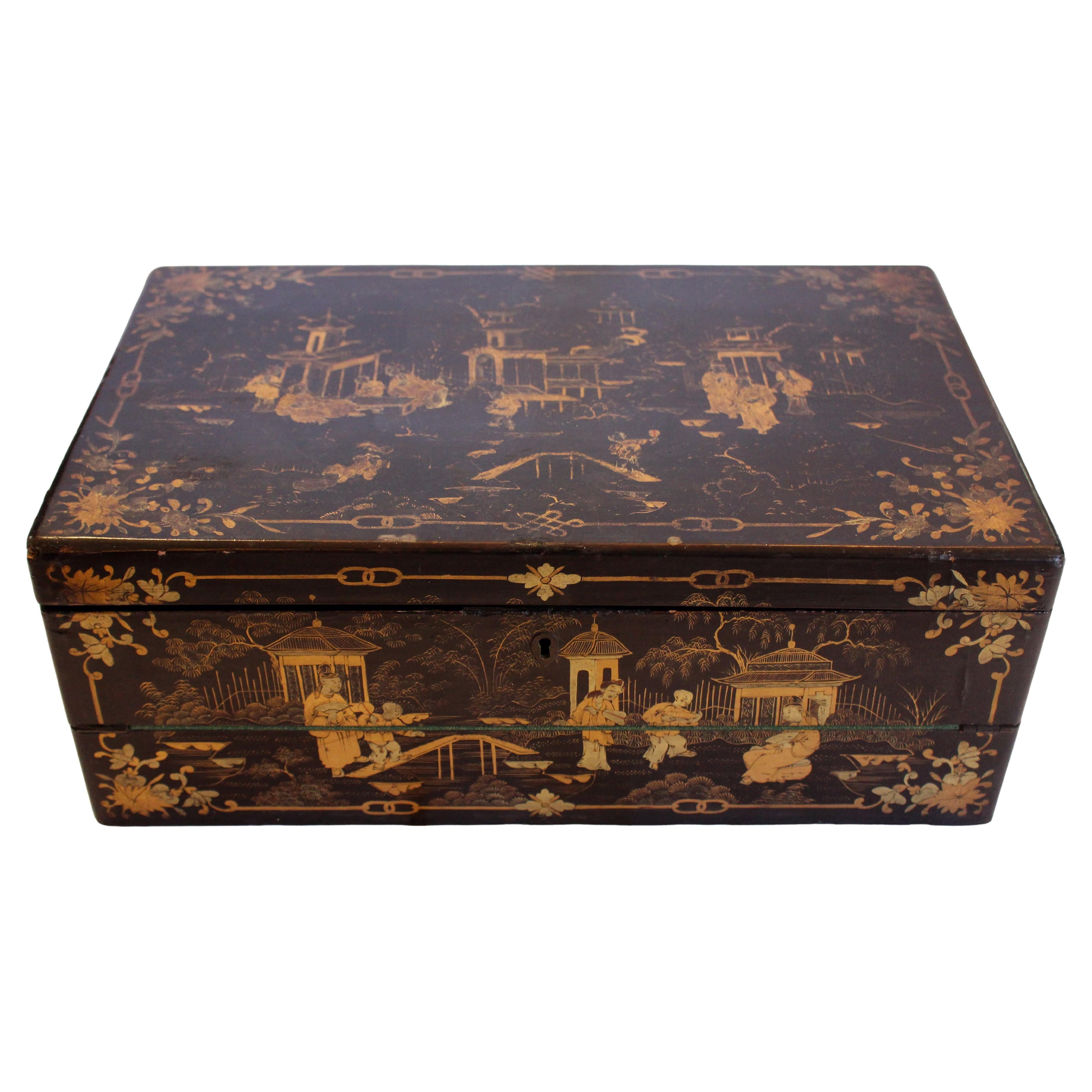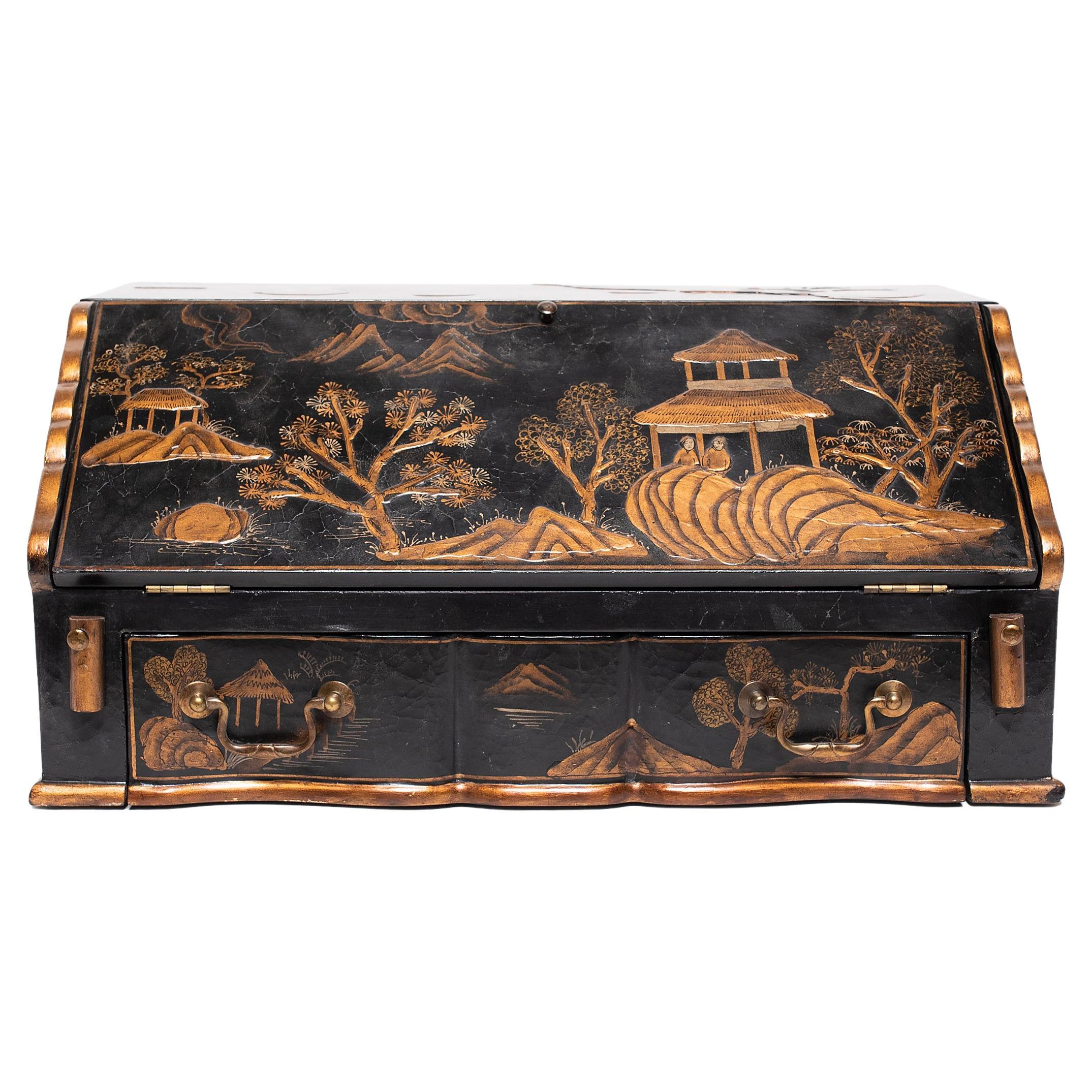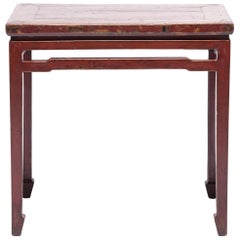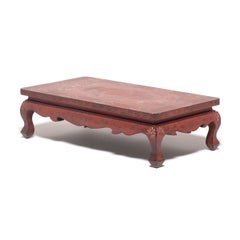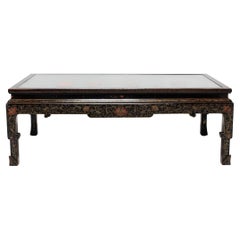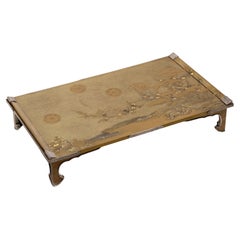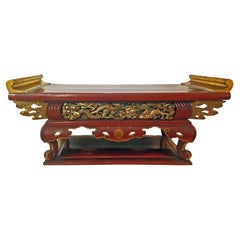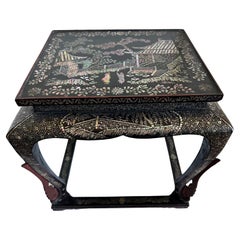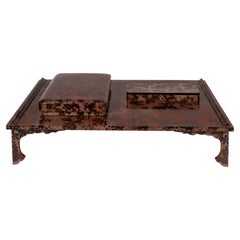Items Similar to Japanese Meiji Gilt Lacquer Writing Desk & Poem Box
Want more images or videos?
Request additional images or videos from the seller
1 of 17
Japanese Meiji Gilt Lacquer Writing Desk & Poem Box
$8,800per set
£6,533.53per set
€7,613.36per set
CA$12,217.24per set
A$13,665.75per set
CHF 7,111.74per set
MX$168,230.09per set
NOK 90,476.05per set
SEK 84,884.37per set
DKK 56,803.28per set
Shipping
Retrieving quote...The 1stDibs Promise:
Authenticity Guarantee,
Money-Back Guarantee,
24-Hour Cancellation
About the Item
With intricate construction and exquisite decoration, this fine tabletop writing set is a masterpiece of Japanese lacquerware. The matching set includes a writing table (bundai) and poem box (tanzaku bako), both decorated with gilt lacquer in the style of takamaki-e and hiramaki-e urushi lacquer.
Framed by everted ends, the lacquered table top is masterfully worked, depicting a robed man seated on a veranda within an idyllic mountain-and-water landscape. Swirling clouds drift overhead and pine trees bend towards the sky, formed of raised lacquer (takamaki-e) and mother of pearl inlay (raden). Dark lacquer at the corners imitate metal hardware and the sculptural corner legs are decorated with raised motifs of maple leaves.
The writing table includes a matching poem box (tanzaku bako), used for storing paper cards of painted calligraphy and poetry. The lid is similarly decorated in shimmering gilt lacquer with a raised design of a fine carriage beneath a pine tree, draped in cloths and shaded by bamboo blinds. The pair possibly depicts scenes from The Tale of Genji, classic Japanese novel written in the early 11th century by the noblewoman, poet, and lady-in-waiting Murasaki Shikibu around the peak of the Heian period.
The underside of the lid is decorated with blossoming branches of mother-of-pearl inlay and a maker's mark attributing the work to the style of master illustrator Ogata Kōrin (1658-1716). The interior of the box and underside of the table are both cloaked in black lacquer sprinkled with flecks of gold for a mesmerizing finish that recalls the night sky.
Each item includes a paulownia (kiri) wood storage case.
Additional Dimensions:
Writing Desk: 25"W x 14.25"D x 5.25"H
Poem Box: 3.75"W x 16"D x 2.25"H
Writing Desk Case: 26.5"W x 15.5"D x 6.75"H
Poem Box Case: 5"W x 17.25"D x 3.5"H
- Dimensions:Height: 5.25 in (13.34 cm)Width: 25 in (63.5 cm)Depth: 14.25 in (36.2 cm)
- Sold As:Set of 2
- Style:Meiji (Of the Period)
- Materials and Techniques:
- Place of Origin:
- Period:
- Date of Manufacture:Early 20th Centuy
- Condition:Repaired: Minor restoration to touch up chips to lacquer along edges. Wear consistent with age and use.
- Seller Location:Chicago, IL
- Reference Number:Seller: PR03561stDibs: LU820040390492
About the Seller
5.0
Platinum Seller
Premium sellers with a 4.7+ rating and 24-hour response times
Established in 1997
1stDibs seller since 2006
1,679 sales on 1stDibs
Typical response time: 1 hour
- ShippingRetrieving quote...Shipping from: Chicago, IL
- Return Policy
Authenticity Guarantee
In the unlikely event there’s an issue with an item’s authenticity, contact us within 1 year for a full refund. DetailsMoney-Back Guarantee
If your item is not as described, is damaged in transit, or does not arrive, contact us within 7 days for a full refund. Details24-Hour Cancellation
You have a 24-hour grace period in which to reconsider your purchase, with no questions asked.Vetted Professional Sellers
Our world-class sellers must adhere to strict standards for service and quality, maintaining the integrity of our listings.Price-Match Guarantee
If you find that a seller listed the same item for a lower price elsewhere, we’ll match it.Trusted Global Delivery
Our best-in-class carrier network provides specialized shipping options worldwide, including custom delivery.More From This Seller
View AllChinoiserie Gilt Lacquer Table Secretaire
Located in Chicago, IL
This charming tabletop secretaire is decorated in gold and black in the Chinoiserie style. The exterior is finished with black lacquer and painted with scenic mountain landscapes, br...
Category
Early 20th Century Chinese Qing Secretaires
Materials
Wood, Lacquer
Chinese Scholarly Lacquered Offering Table, c. 1850
Located in Chicago, IL
This mid-19th century console table was likely used as an offering table bearing incense. Appealing to the rarified taste of China’s literati, this Qing-dynasty table depicts auspici...
Category
Antique Mid-19th Century Chinese Qing Furniture
Materials
Elm
Chinese Low Painted Lacquer Table with Fish Chimes, c. 1900
Located in Chicago, IL
During winter in the colder provinces of China, life revolved around the kang, a heated brick platform that household members would sit or recline upon. Placed on top of the kang, lo...
Category
Early 20th Century Chinese Qing Furniture
Materials
Elm
Painted Chinese Kang Table with Stone Inlay, c. 1900
Located in Chicago, IL
During winter in the colder provinces of China, life revolved around the kang, a heated brick platform that household members would sit or recline upon. Placed on top of the kang, lo...
Category
Early 20th Century Chinese Chinoiserie Furniture
Materials
Agate, Soapstone
Chinese Four Seasons Altar Table, circa 1850
Located in Chicago, IL
This grand table from China's Shanxi province was originally used in a Qing-dynasty household as an impressive domestic altar for ancestor worship. Designed to be the centerpiece of ...
Category
Antique Mid-19th Century Chinese Qing Furniture
Materials
Elm
Chinese Four Drawer Inlaid Altar, c. 1850
Located in Chicago, IL
This shallow console table was crafted over 150 years ago in China's Fujian province, and was originally used as an altar table storing incense a...
Category
Antique Mid-19th Century Chinese Qing Furniture
Materials
Wood
You May Also Like
Japanese Bundai or writting table in gold lacquer with a decor of lake landscape
Located in PARIS, FR
Rectangular bundai writing table on four legs in gold lacquer with black highlights on a nashi-ji background. The top is decorated with a lake landscape with plum trees, pine trees a...
Category
Antique Early 18th Century Japanese Edo Lacquer
Materials
Gold, Bronze
Japanese Lacquered Box / Altar Table, Mid-20th Century
Located in New York, NY
A Japanese lacquered altar table / box, Showa period, 1937.
Teak and Cedar, lacquered in read and black on the outside. Exquisitely carved dragon design in the front and back. The...
Category
Vintage 1930s Japanese Meiji Tray Tables
Materials
Wood
$2,500 Sale Price
20% Off
Antique Japanese Lacquer and Inlay Table from Ryukyu Islands
Located in Atlanta, GA
A small square-form table with lacquer and intricate mother-of-pearl inlay design from Ryukyu Islands kingdom circa 17-18th century. Ryukyuan kingdom was used to be an independent is...
Category
Antique 18th Century Japanese Edo Lacquer
Materials
Mother-of-Pearl, Lacquer
Japanese writting set in waqasa lacquer including bundai ryoshibako and fudebako
Located in PARIS, FR
Set of bundai, ryōshibako and fudebako in wakasa lacquer with an old rose background and black traditional Japanese patterns.
The saya pattern (or sayagata) is composed by Chinese svastikas. This symbol linked to Buddhism, mean intelligence, power and peace. It is a good omen sign.
The kanoko pattern reminds stains on fawn back.
The sakura (cherry blossom) pattern is emblematic of Japan. The blossoming in a short time marks spring beginning and is a symbol of renewal and ephemeral beauty.
There are also traces of calligraphy brush, in reference to the function of the objects.
Bundai is a low table used to put books or scrolls and, later, to write.
Rectangular ryōshibako (letter and document box) with a slightly domed
Fudebako (pencil case) of rectangular format very narrow in its length with two rounded corners, flat cover.
Wakasa lacquerware...
Category
Early 20th Century Japanese Taisho Lacquer
Materials
Lacquer
c. 1860 Chinese Lacquer on Wood Writing Slope
Located in Chapel Hill, NC
Circa 1860 Chinese lacquer on wood writing slope. Made for the English market. Fold over writing surface. Secret drawers. Losses & rubbing commensurate with age, use & delicacy of ma...
Category
Antique Mid-19th Century Chinese Chinese Export Desk Sets
Materials
Lacquer
Early 19th Century Chinese Export Lacquer and Gilt Work Table
Located in Brea, CA
Early 19th century Chinese export lacquer and gilt work table from the Qing Dynasty, with carved gilt dragon head feet, with the table of canted rectangular form, with moulded top, t...
Category
Antique Early 19th Century Chinese Qing Lacquer
Materials
Lacquer
More Ways To Browse
Black Lacquer Storage
Black Lacquer Gold Tables
11th Century
Meiji Wood
Meiji Wood Furniture
Black Lacquer Table Sets
Black Lacquer End Table
Antique Poem
Japan Lacquer Table
Japanese Lacquered Table
Wood Box On Legs
Black Lacquer Inlay
Bamboo Black Lacquered
Asian Storage Box
Japanese Gilt Wood
Japanese Maple
Asian Corner Tables
Antique Lacquer Desk
